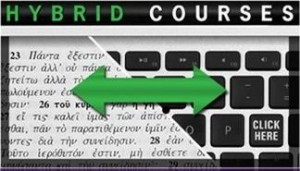Along with the growing popularity of MOOCs, has come a rising debate in regard to their effectiveness. It seems that there is a constant comparison between learning in an online environment and learning in a classroom environment. However, as several new articles suggest, perhaps the best solution can be found in a “hybrid” or “blending” of the two. But does blended learning actually work? What would this mean for the future of education?
 Steve Kolowich’s article for The Chronicle of Higher Education in May of 2013 examines the issue in light of recent protests from university faculty members. San Jose State philosophy professors wrote an open letter in which they stated their refusal to use MOOC material from well known Harvard professor, Michael Sandel, in their classrooms, claiming that students would have neither “self-paced learning” or the “responsiveness of a professor” who caters to the needs of specific students. Kolowich points out that the professors were not opposed to the technology itself, but rather to the important principles of their teaching that this collaboration could destroy. In particular, they feared that universities would “use those materials to phase out local departments and professors.” Although San Jose State said that they plan to let professors have control of the MOOC content, the professors themselves remain skeptical.
Steve Kolowich’s article for The Chronicle of Higher Education in May of 2013 examines the issue in light of recent protests from university faculty members. San Jose State philosophy professors wrote an open letter in which they stated their refusal to use MOOC material from well known Harvard professor, Michael Sandel, in their classrooms, claiming that students would have neither “self-paced learning” or the “responsiveness of a professor” who caters to the needs of specific students. Kolowich points out that the professors were not opposed to the technology itself, but rather to the important principles of their teaching that this collaboration could destroy. In particular, they feared that universities would “use those materials to phase out local departments and professors.” Although San Jose State said that they plan to let professors have control of the MOOC content, the professors themselves remain skeptical.
Another Chronicle article written on the same day by Oregon State associate professor, Andrew Valls, also examines the San Jose State protests. Valls sees the letter as too black and white; it only addresses the difference between strictly online learning and strictly classroom learning. He insists that true hybrid learning is a combination of both, and while nothing will replace classroom learning,online components could provide many advantages. Not only are they convenient, he writes, but sufficient online lectures allow professors to “rethink how we spend our time in the classroom,” spending less time lecturing and more time engaging the students. Valls also doubts that only elite universities can provide successful online content. “Anyone with a computer and an Internet connection” might create a MOOC, lending more varieties of lecturers and courses to the world of online education.
Valls is right in saying that everyone has the opportunity to produce online material, but it is also true that not all material carries the same weight. A course taught by a Harvard professor and one taught by a community college professor would not be comparable, although thanks to MOOCs, both would now be at the same price. However, as Laura Pappano notes in her November 2012 article, teaching ability is also a factor. Perhaps credentials will become less important as MOOC instructors are sought not for their research, but “because of how they teach.” It is a combination of these two factors that may ultimately change the face of education, making hybrid learning a detriment for some, and an enhancement for others.
This post is part of a series on “Making History Online” that involves an examination of open online learning in the field of history funded by the Mellon Digital Humanties grant. Students and faculty at the House Divided Project at Dickinson College are collaborating this summer on a new open, online course called, “Understanding Lincoln,” taught by Prof. Matthew Pinsker and covering ways to teach Abraham Lincoln’s legacy using close readings of his most important writings. This new type of online course represents a unique partnership between Dickinson College and the Gilder Lehrman Institute of American History. The course is available for both graduate credit and free participation. Registration for the course closes on Friday, July 19, 2013. For more information, go to https://www.gilderlehrman.org/programs-exhibitions/understanding-lincoln-graduate-course








Related Articles
No user responded in this post
Leave A Reply
Please Note: Comment moderation maybe active so there is no need to resubmit your comments